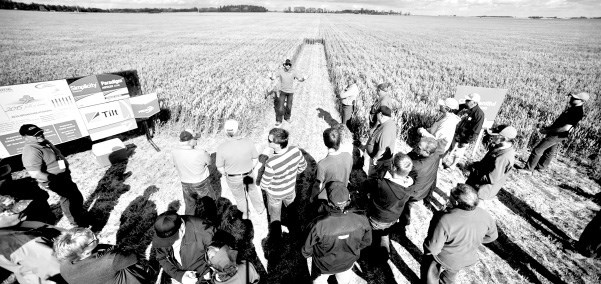Profitability at $10 canola and $6 wheat is achievable, regardless of your operation’s financial dynamics. It all comes down to understanding exactly how much it costs to produce each bushel that you are selling. The more bushels that one can spread those costs over, the cheaper the cost per bushel becomes, thus allowing greater profitability at lower commodity prices. It’s all about maximizing your productivity.
The highest potential yield of any crop is when the seed is still in the bag. Yield is set in the genetics of the seed and yield reductions come in the form of abiotic (unmanageable stresses such as drought, waterlogging, cold soils) and biotic (manageable stresses such as weeds and disease) stresses on the plant during the growing system.
The average canola and wheat yields for the province over the last four years have been 29.3 and 42.95, respectively. These yields take in all forms of management practices from the grower that puts the seed in the ground, applies herbicide and leaves the rest up to Mother Nature, right through to the growers that are using a complete agronomy program encompassing good fertility along with targeted use of fungicides, foliar nutrition and plant stimulator packages.
Prairie Soil Services puts the newest seed genetics, fungicides, nutrition programs and plant stimulators to the test side by side not only with their competitor products but with total untreated check strips. The aim of the testing program isn’t just based around which product is best but to show the grower the value and return on investment of using such products.
The 2014 trials showed an application of a fungicide targeting Fusarium in the wheat crop can preserve five to 10 bushels per acre of the genetic yield which equates to $30 $60 per acre. Furthermore, the use of supplementary micro-nutrition coupled with a plant stimulator package can help maintain yield especially in a year when we experience either extremely rapid growth or in a high stress year when the plant is either under water or experiencing drought stress as was the case in 2015. The results from the tests showed that four to nine bushels per acre preservation of yield in the canola crop and three to nine bushels per acre in the wheat crop. This represents $40 $90 per acre gains in canola and $18 $54 per acre for wheat.
So what we learn from the testing program year over year is that doing something over doing nothing pays every time. Not only does it cover the cost of the products, results have shown net financial gains of up to $80 per acre. With commodity prices at lower levels it is now more important than ever to ensure that we maintain as much genetic yield as we possibly can. The idea of growing more bushels to reduce the per unit cost of production isn’t a new idea, but it is one that we should vigorously strive to achieve.
On 1,000 acres of canola, using a 2015 financial model of inputs and operating expenses, land and equipment costs: every five bushels per acre yield preserved can reduce the cost to produce that bushel by an average of nearly $1 per bushel. Thus, the costs are spread over more bushels and your per bushel cost (of canola) is reduced from $9.11 per bushel to$8.20 per bushel (allin).
Conversely, on a 1,000 acre wheat model, a five-bushel per acre yield preservation can reduce your per bushel cost of production by nearly 50 cents per bushel, from $5.99 to $5.50, which can mean the difference of a pro? t or a loss in 2015.
In a season where it may seem that the cost savings from not using a fungicide or robust nutrient package would be the sensible way to go, the resulting reduction in yield and overall production will end up raising your per bushel cost and greatly reducing your ability to make a profit. Maximizing your productivity is a tried, tested and true methodology and continues to allow profitability irrespective of commodity price volatility.




